C6ISR Market Size
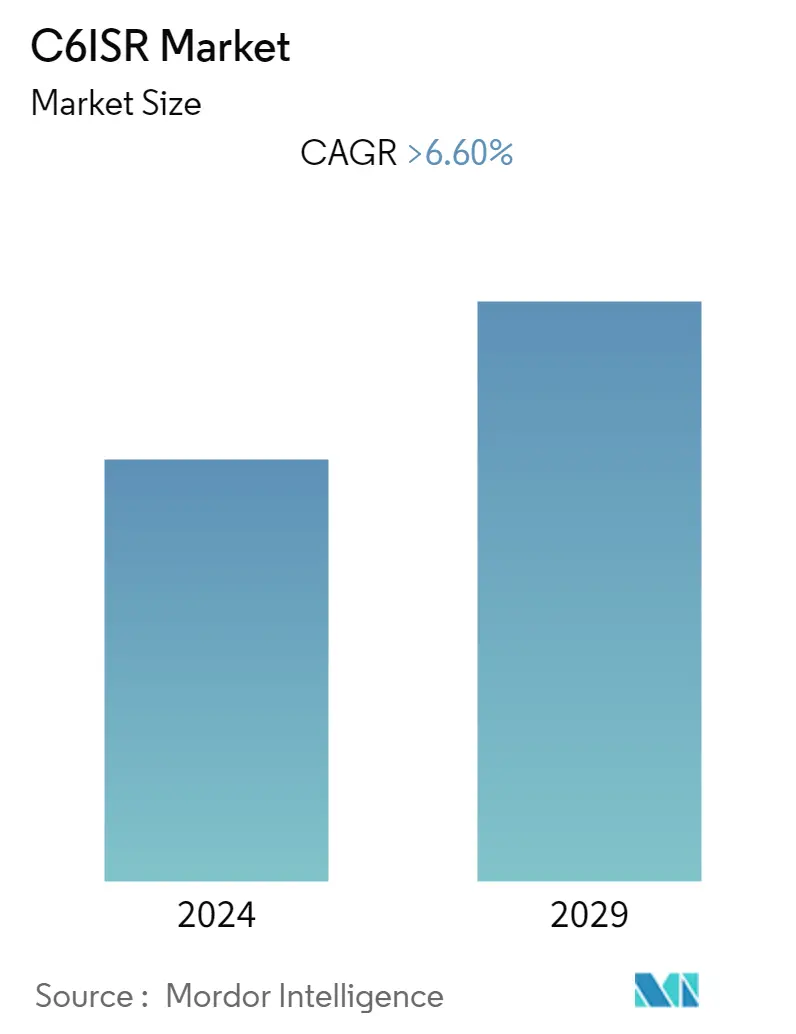
| Study Period | 2019 - 2029 |
| Base Year For Estimation | 2023 |
| CAGR | 6.60 % |
| Fastest Growing Market | North America |
| Largest Market | North America |
| Market Concentration | Low |
Major Players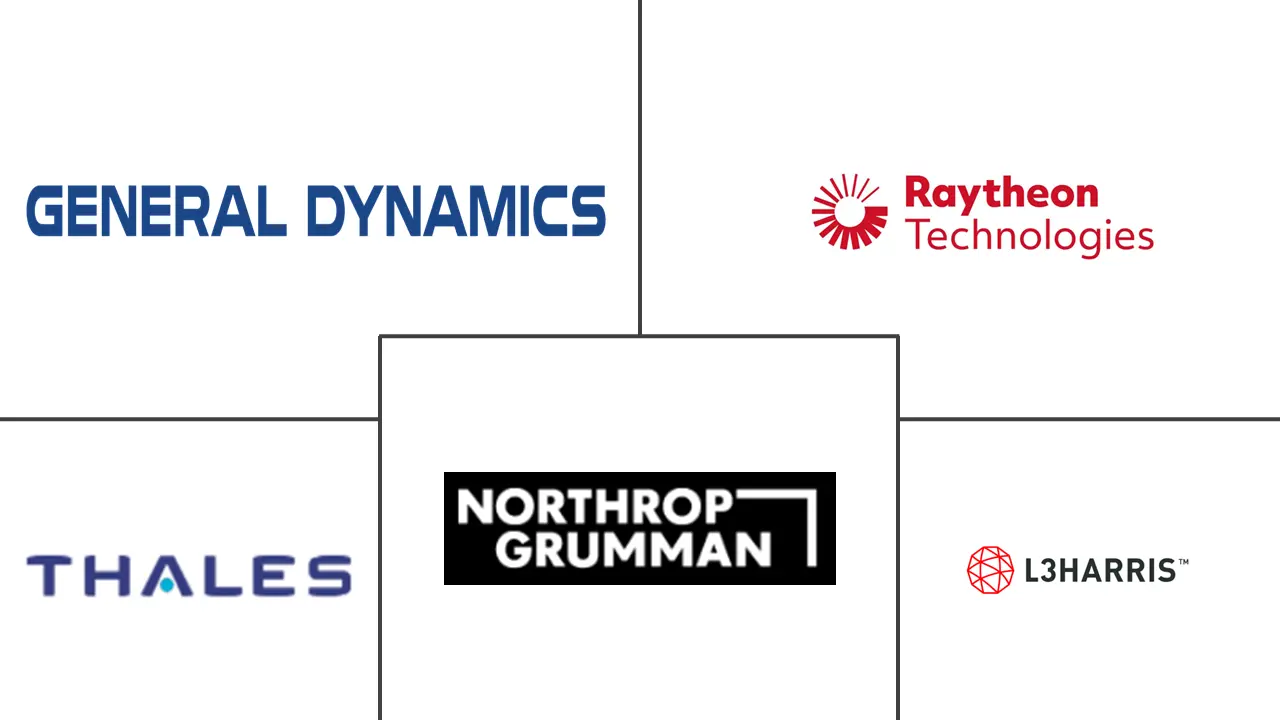
*Disclaimer: Major Players sorted in no particular order |
C6ISR Market Analysis
The C6ISR market is registering a CAGR of 3.1% during the forecast period (2022-2027).
- Despite the COVID-19 pandemic hitting the global economy severely, the impact of the same is not felt on the global military expenditure, which continued to increase in 2020 and 2021. According to the Stockholm International Peace Research Institute (SIPRI), the global military expenditure reached a total of USD 2.113 trillion in 2021, increasing by about 0.7% compared to 2020. Such high expenditure indicates the negligible impact the COVID-19 pandemic had on defense systems development and procurements. The growth in military spending is expected to drive the prospects of the market into focus.
- As the tensions between various nations are increasing, countries are striving to enhance their network centric combat and support capabilities. In this regard, several military programs are currently underway to effectively upgrade the current C4 and C5 - ISR systems to C6ISR capabilities, in each country.
- To facilitate these programs, countries are investing huge amounts into the enhancement of such capabilities, either through indigenous development or through procurement from global vendors. These investments are further driven by the growth in defense expenditures.
- The growth in asymmetric threat environments, globally, is necessitating the need for more modern and advanced C6ISR capabilities for militaries. With rapid technological advancement, the threats that the countries face are increasing both in terms of magnitude and sophistication. Hence, countries are striving to enhance their combat and support capabilities with the procurement of several newer generation C6ISR systems.
- There is a growing emphasis on Network Centric Warfare (NCW) among the global militaries, due to the advantages it offers. The increasing adoption of network-centric warfare is expected to drive the demand for sophisticated C6ISR systems and fuel the growth of the market focus.
- While the adoption of a variety of C6ISR systems is increasing, it is also presenting a host of challenges for the end-users, thereby putting pressure on manufacturers to help them overcome the challenges.
C6ISR Market Trends
This section covers the major market trends shaping the C6ISR Market according to our research experts:
GROWTH IN THE GLOBAL DEFENSE EXPENDITURE
Owing to profound changes in the international strategic landscape, the configuration of international security systems has been undermined by the growing hegemonism, unilateralism, and power politics, which fueled several ongoing global conflicts.
Uncertainties in territorial rights, political tensions, and the quest for universal dominance among the military powerhouses are among the major causes disturbing the geopolitical scenario. In this regard, the most common reaction of the governments is to increase their military spending, to improve security in their respective countries.
Despite the economic impact of the COVID-19 pandemic, global defense expenditure continued to increase in 2020 and 2021. According to SIPRI, the global military expenditure in 2021 rose to USD 2113 billion, an increase of 0.7% in from 2020. billion. Global spending in 2021 was 12% higher than in 2012. The five largest military spenders in 2021 were the United States, China, India, the United Kingdom, and Russia, which together accounted for 62% of world military spending.
As the threats for the countries become higher, enhancing the militaries' C6ISR capabilities becomes important for every country. In this regard, several military programs are currently underway to effectively upgrade the C6ISR capabilities of various countries. To facilitate these programs, countries are investing huge amounts into the enhancement of such capabilities, either through indigenous development or through procurement from global vendors. These investments are further driven by the growth in defense expenditures.
The market studied is likely to grow steadily over the forecast period due to the growing investments toward obtaining faster and more secure C6ISR capabilities for the global armed forces. Countries are progressively adopting these systems for better situational awareness, secure and faster communication, and threat detection capabilities. On account of capability enhancement initiatives undertaken by global military powerhouses such as the United States, the United Kingdom, China, and India, the high demand for C6ISR systems is expected to drive the market during the forecast period.
In addition to the traditional demand from the US and European markets, several countries in Asia-Pacific, the Middle East, and Latin America are now focusing on augmenting their situational awareness and combat support capabilities. In this regard, several military C6ISR system development procurements, and modernization programs are currently underway, to enhance the combat capabilities of the armed forces. These programs are supported by the defense budgets.
In recent years, countries in these regions have placed orders for newer generation platforms and equipment that incorporate C6ISR systems when several such development programs are also underway. These programs are expected to run during the forecast period.
The development and procurement of such platforms and equipment demand huge defense spending from the countries, as the cost of the systems is immense. Thus, the growth in defense spending is expected to drive the growth of the market in the coming years.
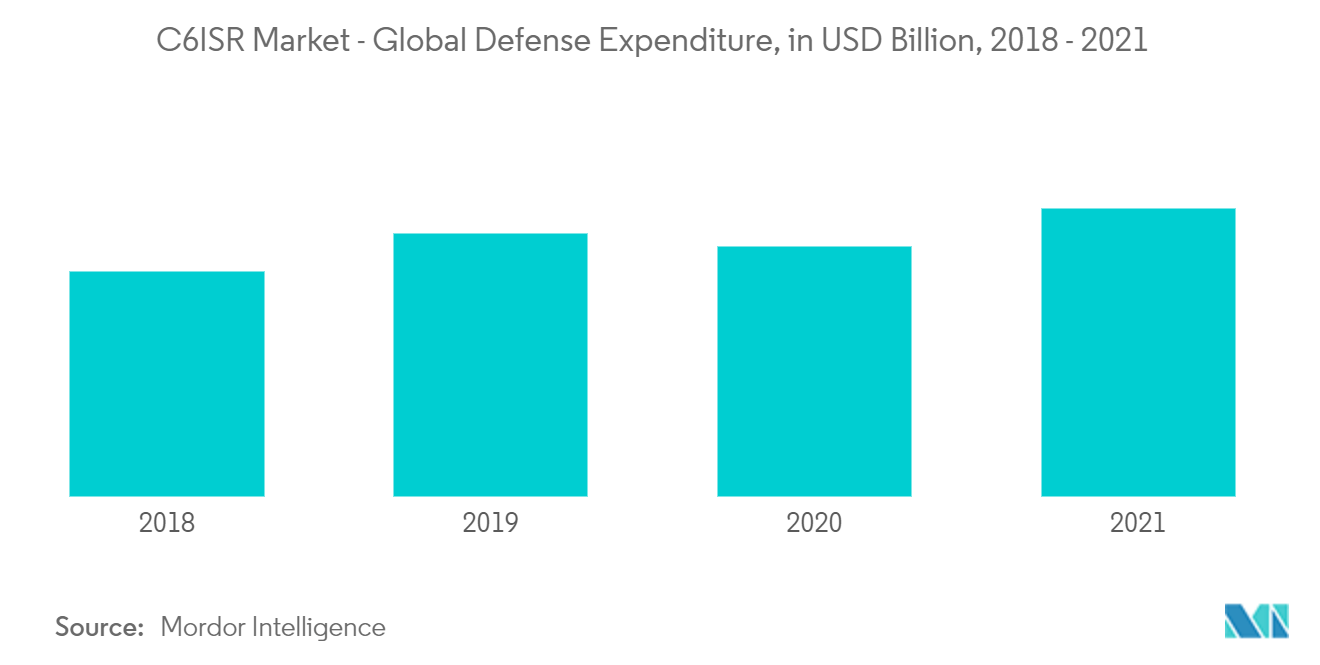
North America is Expected to Witness Highest Growth Rate
The nature of battles has changed drastically with the advent of technology. For various military requirements, including communication, defense agencies globally are looking for advanced capabilities to meet the demand for more operationally responsive forces.
Global defense forces deploy the C6ISR systems to monitor and analyze points of interest located in hostile territory. Countries, such as the United States, Russia, and China, diverted their efforts toward the development of sophisticated and powerful C6ISR systems that can penetrate the defenses of hostile adversaries to obtain mission-critical information.
There is a growing emphasis on Network Centric Warfare (NCW) among the global militaries. Network-centric warfare involves the combination of emerging tactics, techniques and procedures that a networked force can employ to create a decisive warfighting advantage. In recent years, the way in which forces communicate, disseminate intelligence, are issued orders, and report back to their commanders has been revolutionized using networks. More specifically, computer, radio, and data networks link nearly all military assets at a state's disposal to each other and to the decision-makers.
The prime objectives of this concept are to make the battlefield more transparent, to achieve information dominance and create situational awareness at all levels, to disseminate target information in a timely manner to those who needed it, and to adjust C6 doctrine accordingly. On a broad scale, the objective was to shorten the sensor-to-shooter time and improve responsiveness
The networks that extract data from multiple data feeds to assimilate into a single combined intelligence picture amplify the effect of data collection by individual C6ISR systems, as overlaying the feeds of multiple systems enhances situational awareness to a level far beyond the capabilities of an individual system.
The focus of NCW is the assimilation of minimum information that needs to be exchanged. Thus, effective ways to capture that information and portray it into actionable intelligence require the integration of sophisticated sensors and subsystems to capture actionable intelligence.
Thus, the increasing adoption of network-centric warfare is expected to drive the demand for sophisticated C6ISR systems and fuel the growth of the market in focus during the forecast period.
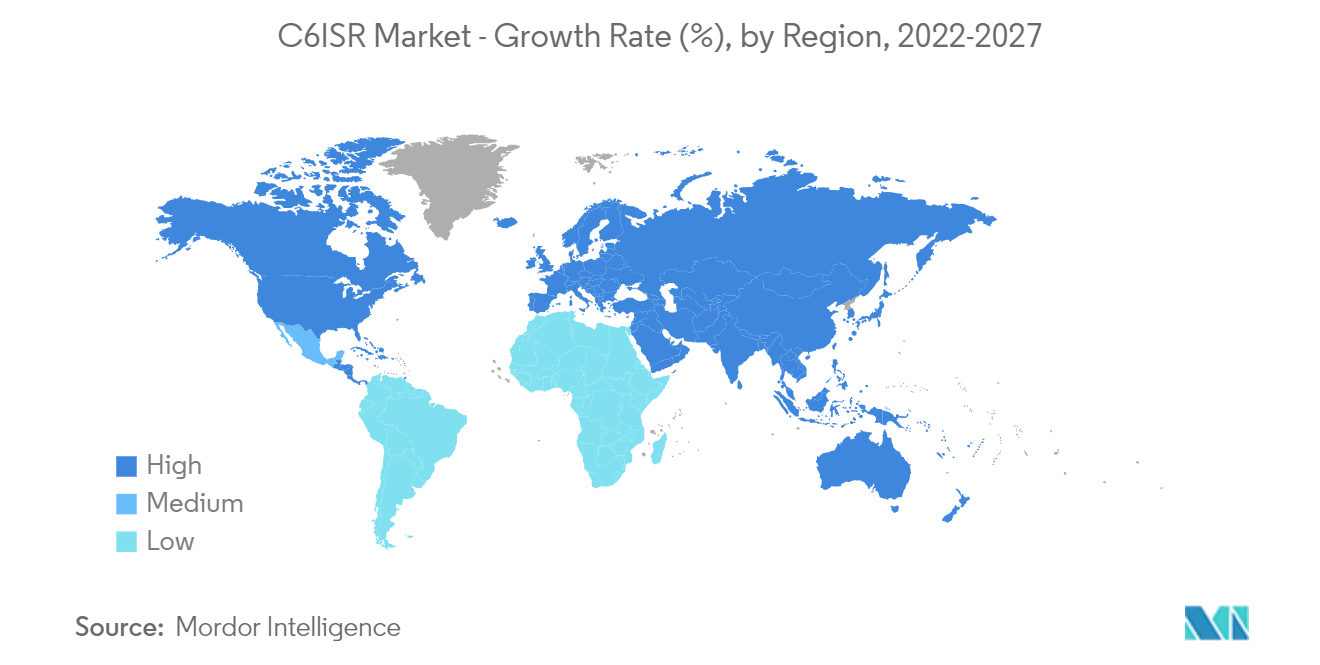
C6ISR Industry Overview
The C6ISR market is fragmented, with many international and regional players supporting the armed forces worldwide. Some of the prominent players in the C6ISR market are Northrop Grumman Corporation, Raytheon Technologies Corporation, L3Harris Technologies Inc, Thales Group, and General Dynamics Corporation. The companies are formulating new strategies to expand their presence in various regions and capture new contracts from the armed forces. The market players are actively forming JVs and partnerships with local manufacturers to expand their presence in other regions. In addition to such plans, investments into R&D for developing C6ISR systems that are integrated with technologies like AI and quantum networking are also anticipated to help the companies attract new customers and increase their share in the market in the coming years.
C6ISR Market Leaders
-
General Dynamics Corporation
-
Raytheon Technologies
-
Thales Group
-
Northrop Grumman
-
L3 Harris Technologies
*Disclaimer: Major Players sorted in no particular order
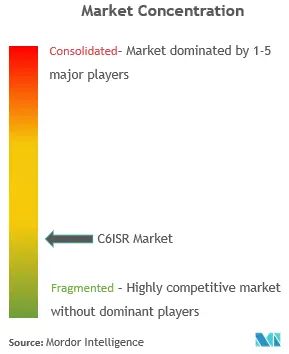
C6ISR Market News
In March 2022, Leonardo S.p.A was selected by the Qatari Emiri Naval Forces (QENF) to provide a Naval Operation Centre (NOC) to provide command, control, and coordination of operations at territorial water, Exclusive Economic Zone (EEZ), and adjacent waters simultaneously to enhance cooperation with various national agencies in charge of maritime security.
In September 2021, the French Navy announced the procurement of 12 Falcon 2000XLS aircraft from Dassault Aviation under the AVSIMAR program. Thales Group secured the contract to provide SEARCHMASTER surveillance radar and mission navigation system for the aircraft.
C6ISR Market Report - Table of Contents
1. INTRODUCTION
- 1.1 Study Assumptions
- 1.2 Scope of the Study
2. RESEARCH METHODOLOGY
3. EXECUTIVE SUMMARY
4. MARKET DYNAMICS
- 4.1 Market Overview
- 4.2 Market Drivers
- 4.3 Market Restraints
-
4.4 Porter's Five Forces Analysis
- 4.4.1 Bargaining Power of Buyers/Consumers
- 4.4.2 Bargaining Power of Suppliers
- 4.4.3 Threat of New Entrants
- 4.4.4 Threat of Substitute Products
- 4.4.5 Intensity of Competitive Rivalry
5. MARKET SEGMENTATION
-
5.1 Platform
- 5.1.1 Air
- 5.1.2 Land
- 5.1.3 Naval
- 5.1.4 Space
-
5.2 Purpose
- 5.2.1 C6 (Command, Control, Communications, Computers, Cyber-Defense and Combative Systems including Meteorology and Calibration support)
- 5.2.2 ISR
- 5.2.3 Electronic Warfare
-
5.3 Geography
- 5.3.1 North America
- 5.3.1.1 United States
- 5.3.1.2 Canada
- 5.3.2 Europe
- 5.3.2.1 United Kingdom
- 5.3.2.2 Germany
- 5.3.2.3 France
- 5.3.2.4 Russia
- 5.3.2.5 Rest of Europe
- 5.3.3 Asia Pacific
- 5.3.3.1 India
- 5.3.3.2 China
- 5.3.3.3 Japan
- 5.3.3.4 South Korea
- 5.3.3.5 Rest of Asia Pacific
- 5.3.4 Latin America
- 5.3.4.1 Brazil
- 5.3.4.2 Rest of Latin America
- 5.3.5 Middle East & Africa
- 5.3.5.1 UAE
- 5.3.5.2 Saudi Arabia
- 5.3.5.3 Turkey
- 5.3.5.4 Rest of Middle East & AFrica
6. COMPETITIVE LANDSCAPE
- 6.1 Vendor Market Share
-
6.2 Company Profiles*
- 6.2.1 Lockheed Martin Corporation
- 6.2.2 BAE Systems plc
- 6.2.3 Northrop Grumman Corporation
- 6.2.4 Elbit Systems Ltd
- 6.2.5 Raytheon Technologies Corporation
- 6.2.6 Thales Group
- 6.2.7 L3Harris Technologies Inc
- 6.2.8 General Dynamics Corporation
- 6.2.9 Israel Aerospace Industries Ltd
- 6.2.10 CACI INTERNATIONAL INC.
- 6.2.11 Saab AB
7. MARKET OPPORTUNITIES AND FUTURE TRENDS
** Subject To AvailablityC6ISR Industry Segmentation
The C6ISR market is segmented by Platform, By purpose, and By geography. By platform, the market is segmented into Air, land, sea, and space. By purpose, the market is segmented into, Command, Control, Communications, Computers, Cyber-Defense and Combative Systems(C6), Intelligence, Surveillance, and Reconnaissance (ISR), and Electronic Warfare (EW)
For each segment, the market sizing and forecasts have been provided by value (USD billion).
| Platform | Air | |
| Land | ||
| Naval | ||
| Space | ||
| Purpose | C6 (Command, Control, Communications, Computers, Cyber-Defense and Combative Systems including Meteorology and Calibration support) | |
| ISR | ||
| Electronic Warfare | ||
| Geography | North America | United States |
| Canada | ||
| Geography | Europe | United Kingdom |
| Germany | ||
| France | ||
| Russia | ||
| Rest of Europe | ||
| Geography | Asia Pacific | India |
| China | ||
| Japan | ||
| South Korea | ||
| Rest of Asia Pacific | ||
| Geography | Latin America | Brazil |
| Rest of Latin America | ||
| Geography | Middle East & Africa | UAE |
| Saudi Arabia | ||
| Turkey | ||
| Rest of Middle East & AFrica |
C6ISR Market Research FAQs
What is the current C6ISR Market size?
The C6ISR Market is projected to register a CAGR of greater than 6.60% during the forecast period (2024-2029)
Who are the key players in C6ISR Market?
General Dynamics Corporation, Raytheon Technologies, Thales Group, Northrop Grumman and L3 Harris Technologies are the major companies operating in the C6ISR Market.
Which is the fastest growing region in C6ISR Market?
North America is estimated to grow at the highest CAGR over the forecast period (2024-2029).
Which region has the biggest share in C6ISR Market?
In 2024, the North America accounts for the largest market share in C6ISR Market.
What years does this C6ISR Market cover?
The report covers the C6ISR Market historical market size for years: 2019, 2020, 2021, 2022 and 2023. The report also forecasts the C6ISR Market size for years: 2024, 2025, 2026, 2027, 2028 and 2029.
C6ISR Industry Report
Statistics for the 2024 C6ISR market share, size and revenue growth rate, created by Mordor Intelligence™ Industry Reports. C6ISR analysis includes a market forecast outlook 2029 and historical overview. Get a sample of this industry analysis as a free report PDF download.



